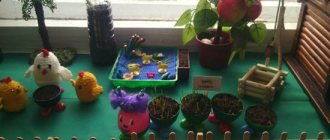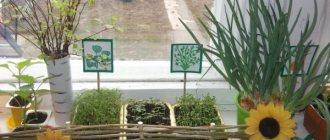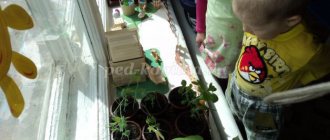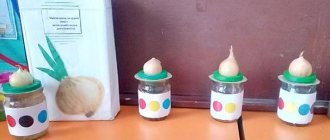Why do you need a vegetable garden in kindergarten?
A vegetable garden in a kindergarten is needed to introduce preschoolers to nature and its seasonal changes.
In addition, a vegetable garden in a kindergarten and the feasible work of children on its territory influence the formation of elementary environmental concepts in preschoolers.
A vegetable garden in a kindergarten is also an opportunity to see the results of your work. Joint work in the garden provides an opportunity to learn responsibility, contributes to the formation of work skills and the unification of the children's team. And, of course, a vegetable garden in a kindergarten and work in the fresh air help preserve and strengthen the children’s health.
• Regulations on the natural site of the Omsk BDOU "Kindergarten No. 21 of a combined type"
• Work grid
• Content of the activity
• Work calendar for the 2013 - 2014 academic year
• Work calendar for the 2014 - 2015 academic year
• Work schedule for summer 2015
AVAILABLE TYPES OF WORK
IN THE FLOWER GARDEN, VEGETABLE GARDEN
FOR PRESCHOOL CHILDREN
The first spring tillage is done by adults. It is done as early as possible. Children dig again. Digging is only available to children of senior preschool age. Not all children should be involved in digging, but in subgroups. The teacher explains in detail how to use a shovel correctly and how to turn over the earth. When digging, children may be distracted, because... This is a short rest. After digging, the children take part in laying out the beds and leveling the beds with a rake.
Children in all groups can sow seeds. You must first water the beds properly and sow only in damp soil. It is necessary to emotionally tell that such a small seed contains life, that in the presence of heat and moisture, a sprout will hatch from the seed. It is necessary to examine the sprouted seeds and sprouts in the group. The children must be told what they will plant.
We planted a vegetable garden, look what’s growing!
Natalya Grigorievna Konovalova, teacher at MBDOU No. 27, Uglegorsk, Sakhalin region
This is possible when children have at least basic knowledge about nature, master simple methods of growing plants, learn to observe nature and see its beauty. It is on this basis that children’s love for nature, their native land, and the Motherland is formed.
Preschoolers are in kindergarten almost every day (except weekends), from morning to evening. Where can they learn hands-on interactions with nature?
For this purpose, we have our own vegetable garden in each section of our kindergarten. A vegetable garden in a kindergarten is one of the conditions that is necessary for the implementation of environmental education of children in kindergarten. Its presence promotes the child’s contact with natural objects and introduces preschoolers to seasonal changes.
Here children have the opportunity to observe the development of plants, remember their names and appearance characteristics, note characteristic features, acquire watering and care skills, and understand the role of nature in human life. In addition, this is a feasible joint work of children, which makes it possible to learn responsibility, contributes to the unification of the children's team, and the preservation and strengthening of children's health. A vegetable garden in a kindergarten is also an opportunity to see the results of your work.
In our garden, the children, together with the teacher, planted dill, lettuce, carrots, beets, onions, parsley, and peas and take care of them. In the process of observation and hard work, they learned that their growth and development depend not only on sunlight, heat, moisture, soil, but also on care.
We teach children watering, loosening, weeding, we explain that they loosen so that air can flow better to the roots of plants, we teach them to distinguish cultivated plants from weeds.
Working in the vegetable garden and flower garden in spring and summer, preschoolers gain basic understanding of growing plants from seeds.
Such constant activity is a method of environmental education: it teaches children to systematically think and really care about the plants that are in the same living space as them.
Working in nature allows a child to see the result of his help to living things, and contributes to the development of sympathy, compassion, and empathy for living beings in children.
Thus, with competent guidance from the teacher, a vegetable garden in a kindergarten has a huge impact on the harmonious development of children.
[mailerlite_form form_id=4]
HOW TO CREATE A CHILDREN'S GARDEN
It may consist of one or several (if you have more than one child) beds. To make it interesting for the child, and for him to understand that this is his personal “possession,” the children’s garden is planted away from the adult. It should be located so that it is convenient for the child to approach it from any side.
The beds should not be in an open sunny place, otherwise the small gardener may overheat in the sun. It is best to choose a small area in diffuse partial shade, for example, under an old apple tree.
In order for a child to feel the difference between his own and adult beds, it is better to give them some unusual shapes - a semicircle, a triangle, an oval. It is clear that the beds should be small so that the child can care for the plants from all sides.
The child’s contribution to the children’s garden depends on his age. Psychologists recommend starting this work with children after four years of age. It is clear that the contribution of children to the children's garden will be minimal. You, the adults, must prepare the land, form the beds, and mark the furrows. At the same time, you must discuss all your actions with your child.
Let him decide what shape the bed will be. What will grow on it, what and how you will plant and sow together. Be sure to buy your kids a set of children's agricultural tools: a shovel, a rake, a hoe, a small watering can.
Let him and you use his rakes to loosen the soil in the garden bed. But he must sow the seeds himself, and water the crops too. It doesn’t matter that you then finish all the work for him. He won't even notice it.
For older children, shift some part of the preparatory work onto their shoulders, but also resolve all other issues together with them.
MAGAZINE Preschooler.RF
Project “Vegetable garden on site”Project stage: Project under implementation
The goal of the project: to create optimal conditions for conducting environmental classes in the garden in all age groups of the kindergarten.
Project objectives:
- plant a vegetable garden on the territory of the kindergarten in a place designated for growing vegetables
- involve parents in the process of garden design, identify business partners among them
- teach how to care for plants, give children a clear idea of the need for light, heat, moisture, and soil for plant growth
- develop the ability to jointly solve a given problem (collective planting, weeding, site decoration)
- development of interest in research activities in the process of growing plants
- expand children’s knowledge about the structural features and growth conditions of vegetable crops and garden plants
- involve children in active independent activities in growing plants
- develop children's creative abilities, curiosity, search activity
- to cultivate a careful and caring attitude towards plants, towards the nature of the native land, towards human labor
- activate speech and enrich children's vocabulary
- develop emotional responsiveness
- form partnerships between teachers, children and parents.
Results achieved:
Children will have a desire to learn more about the plant world, acquire new knowledge about the structure of plants and the influence of external factors (light, heat, moisture) on their growth. Children will strive to take a responsible approach to the assigned task.
Social significance of the project:
The ability to love nature does not come on its own; children’s conscious attitude towards it is based on knowledge that is presented by adults in a vivid emotional form. The greatest result is achieved through direct observation in living nature, perception by all senses. By watching a plant grow from a seed, a child learns to cherish and love nature, to see its beauty and uniqueness.
Activities carried out within the framework of the project:
Project stages. I. Preparatory stage:
- Studying methodological literature on the organization and placement of a vegetable garden on the territory of a kindergarten.
- Creation of a project for the organization and placement of a vegetable garden on the territory of a kindergarten, the work of teachers with pupils of all age groups in the garden of a kindergarten.
- Analysis of the technical condition of the territory and soil to optimize the work of creating a vegetable garden.
- Drawing up an estimate with a list of necessary expenses for the implementation of the project.
II. The main stage of the project implementation.
During the main stage it is necessary to:
- Water supply to the site.
- Availability of planting material (seeds, cuttings, rhizomes).
- Availability of gardening equipment.
- Layout of the garden, distribution of territory between groups.
- Digging the soil, loosening the earth with a rake, breaking up clods, removing grass residues.
- Renewal and enrichment of soil with fertilizers.
- Laying out the beds.
- Examination and comparison of seeds, cuttings, rhizomes before planting.
- Sowing seeds and planting cuttings and rhizomes in the ground.
- Observation of seedlings, keeping an “Observation Diary”.
- Detailed introduction to plants (stem, leaves, flowers, smell).
- Caring for seedlings: watering, weeding, loosening.
- Decorative design of the vegetable garden.
- Providing photo and video materials about the progress of the project, demonstration of the film “Green leaves from every sprout”
Work with parents: 1. Conducting consultations and conversations on the project.
2. Organizing the active assistance of parents in creating the necessary conditions for the implementation of the project.
3. Involving parents in labor activities in the garden.
4. Providing photo and video materials about the progress of the project, showing the film.
Project scope:
0+ students, parents, teachers, partners
Resources spent:
Time resources spent on the project from idea to implementation stage 3 months
Project start date: 04/01/2017
| Next > |
Consultation for educators. Working with children in the flower garden and vegetable garden
Consultation for educators “Organization of work with children in a flower garden, vegetable garden”
Author: Olga Vasilievna Yakovleva, educator, State Budgetary Educational Institution “School No. 842”, Moscow Description of work: I offer you a consultation for educators “Organization of work with children in a flower garden, vegetable garden.” This material will be useful to educators, senior educators, and methodologists of preschool departments. The consultation is aimed at improving the professional competence and pedagogical skills of educators in implementing the tasks of environmental education of preschool children. Goal: Improving the work on environmental education of preschoolers in the Institution. Increasing the knowledge, professional competence, and pedagogical skills of educators when organizing work with children in the flower garden and vegetable garden.
Creating a flower garden and vegetable garden on the land plot of a preschool institution has great educational significance. Children, together with the teacher, growing plants on the site, learn to care for them, learn about the life of plants, and learn to work and take care of green spaces. Vivid impressions received in childhood from communication with living nature remain in the memory for a long time and serve as the foundation for the formation of correct ideas about nature.
Construction of beds
In the common garden, each group is allocated its own beds for growing vegetables. Regardless of the area and location of the garden, the beds are made of the established size: length - 2.5-3 m, width - 70-80 cm, row spacing - 50-60 cm. The height depends on the humidity and structure of the soil: on a flat surface with light and loose soil - 15-20 cm, in low and damp places - 40-50 cm. The surface of the ridges is leveled with a rake, making them slightly trough-shaped (non-convex), so that when watering water does not roll off the ridges. The sides are lightly slammed with the back of the rake so that they become slightly inclined, then the soil will not crumble.
It is necessary to prepare for work in the garden: preparing agricultural equipment for children and adults, preparing seeds, growing seedlings, planning a plot for a garden, preparing the soil for sowing. It is necessary to have a sufficient number of shovels, rakes, watering cans, and buckets so that as many children as possible can take part in the work at the same time. It is very important that the equipment matches the strength and growth of children, is comfortable and has an attractive appearance.
Selection of vegetable crops for the garden
When choosing vegetables, the age of children should be taken into account. On the beds of children, it is advisable to plant onions, sow peas, beans or beans, and radishes. During the winter, children plant onions in boxes several times, so they are familiar with planting and care techniques. Growing onions in the garden will expand children's knowledge: they will learn that onions can be grown not only in boxes, but also in beds.
The seeds of peas and beans are large, so each child, under the guidance of a teacher, can sow and plant these seeds. In addition, beans and peas are less demanding in terms of care than other crops, and at the same time, they are interesting and accessible for children of younger groups to observe.
New and more difficult is sowing radish seeds, but with proper organization of work, children do a good job of sowing these small seeds.
On the plot of older groups, you can grow vegetables that differ in terms of ripening and economic purposes: leafy vegetables - lettuce, cabbage, root vegetables - radishes, carrots, beets, etc., fruits - cucumbers, zucchini, pumpkin, tomatoes, legumes - peas, beans, beans .
Flower garden
There must certainly be flowers on the kindergarten site. They decorate the area, make it cozy, picturesque and joyful, and provide the teacher with rich material for working with children. The variety of plant forms, the combination and brightness of colors, the aroma and beauty of flowers arouse children's interest in plants and contribute to aesthetic education. During work and observations organized by the teacher, children easily and quietly acquire a lot of knowledge about the life of plants and acquire skills in caring for them.
There are a lot of plants suitable for decorating a flower garden. It is impossible to have them all on the site, and it is not necessary. You can plant any of them: they are all good in their own way and children like them. It is best to choose those plants that are more unpretentious and require less care. Such plants primarily include perennials and self-seeding plants.
Organization and content of observations in the garden, in the flower garden
Second junior group The main goal of observations is to attract children's attention to plants, arouse interest in them, and cultivate a caring attitude towards living organisms. Children of this age are introduced to the main phenomena in the life of plants: they grow from seeds, bloom, and produce fruits (vegetables). By caring for and observing plants, children gradually acquire knowledge about the appearance of some plants. The words grow, grew, will grow
become more understandable. Considering the great emotionality and motor activity of children, it is very important to connect observations with joyful experiences and actions. To do this, in the process of observation, you should use various techniques: playful, practical instructions (find, show, smell, touch, find the same, etc.), verbal (questions, explanation, artistic expression, etc.).
Short-term but often repeated observations are carried out with children, since children get tired quickly, their attention is unstable, and not with the whole group at the same time, but with a small number of children. Children's first acquaintance with flower garden plants can be done after the seedlings have taken root. The teacher takes the children to the flowerbed and shows them bright illustrations of flowers in order to attract attention. Then the plants on the site are examined. The teacher notes that they are still small. Suggests watering the plants so that they grow well. Shows how to do it - at the root, so as not to break the leaves. In the following days, the teacher involves the children in watering, explaining that after watering the plants grow well and flowers appear faster. When the first flowers appear, the teacher takes the children to the flowerbed and asks why it has become so beautiful, what’s new in it. Children look at the flowers, the teacher names them. Teaches children to learn the names of flowers, distinguish them by color and size.
It is best to start getting acquainted with the growth of vegetables when the first leaf appears on the plants in the beds. From this moment on, you can involve children in caring for them (watering). The teacher organizes the first observations in order to consolidate children’s ideas that plants grow from seeds. He suggests going to the garden to see what has grown there. Children examine the seedlings, then the teacher invites each child to carefully select 2 plants from the row with their fingers and show their leaves. Shows how to water plants using a watering can with a strainer.
Later, you can conduct longer observations of the growth of familiar plants. Their goal is to consolidate the first elementary ideas that plants grow and change, and to teach them to identify the characteristic features of plants. Gathering the first harvest of vegetables will be no less interesting for children.
Middle group Children 4-5 years old also find it difficult to trace the entire development cycle of plants. Using vivid and convincing examples, the teacher introduces some qualitative changes in plants during the growth process, the sequence in the onset of individual phases of their development (the appearance of a leaf, the transformation of a bud into a flower, a flower into a fruit, etc.). It is very important to arouse children's interest in observations. For this purpose, simple games-assignments such as “Find the same”, “Who noticed?”, “Guess by smell”, “Guess by touch” (with vegetables) are used.
At the same time, the teacher teaches children to identify and name one or two characteristics of a plant that distinguish it from others, develops children’s attention and interest in plants and their diversity. When friendly shoots appear on the beds, the children are involved in systematic care of them, first of all, watering.
It is very important to teach children to compare plants by color and leaf shape. During the examination, the teacher asks questions: “What did we recently plant in the beds to make the plants grow? Why do plants grow in rows? Why did different plants grow in different beds?” In the middle group, children are led to establish connections and dependencies between specific factors: they not only look at flowers, but also pay attention to the bud that is ready to open, and wait for the flower to appear. The teacher teaches children to make conclusions and conclusions that are accessible to them.
You should observe the condition of the plants after heavy watering or rain on hot days: the leaves straighten and stretch upward. As a result of these observations, the teacher leads the children to establish the dependence of the condition of plants on the presence or absence of moisture in the soil, its importance for plant life, and shows the connection between their condition and their care. During the observation process, it is necessary to ensure that children correctly name the parts of plants (stem, leaves, flowers, buds, roots). The teacher teaches children to compare the plants of two neighboring beds: the peas have grown a stem, the radishes and beets have no visible stems - many leaves have grown. Particularly interesting for children is observing the appearance of fruits and root crops in the garden beds.
Senior and preparatory groups for school In the process of introducing older preschoolers to the life of plants, more complex problems are solved than at the previous stage. Children are led to a generalization of accumulated ideas about plants, the formation of concepts (for example, “cultivated” and “wild” plants), an awareness of the dependence of plant life on natural factors and human labor, and they develop the ability to see some patterns in the life of plants (graduality, consistency and variability in process of growth and development).
With older children, not only episodic (short-term) observations are carried out, but also long-term observations (over many days or weeks). The teacher organizes episodic observations when it is necessary to attract children’s attention to new phenomena or consolidate knowledge. To develop observation skills, the ability to compare and identify essential characteristics of plants, it is useful to conduct comparison exercises. In the older group, you can give two flower garden plants for comparison (for example, cosmos and lily, nasturtium and zinnia). In the preparatory group, they give a more complex task: compare two or three varieties of the same plant species, for example, Turkish and Chinese cloves, large double and dwarf marigolds. Establishing, when comparing both different and similar characteristics, develops the child’s thinking and provides an opportunity for an elementary understanding of the variety of plants and the role of man in the transformation of nature. During long-term observations, the teacher returns to the same plant several times over a certain period of time, noting the changes that have occurred in it and linking them with previous ones, for example, “Transforming a flower into a berry,” “From seed to seed” (peas, cucumbers, sunflower ) etc. Observations should not be overloaded; there is no need to try to tell at once everything that is important and interesting for children to know about this object. But every time you need to give children something new that expands their understanding of this plant. To develop interest in plants, the teacher can use various techniques, including games: “Who will see first?”, “Who will find it faster?”, “How many petals does a daisy or rose hip have?” You can let children guess flowers by smell, vegetables and fruits by touch and taste.
Poems spoken by the teacher in a timely manner, an apt folk saying, a proverb or a riddle emphasize the characteristics of a given plant and contribute to better memorization. It is good to use small excerpts of literary text, which contributes to the formation of especially vivid, lasting images and at the same time enriches children's vocabulary. To better consolidate the received ideas, observations are accompanied by subsequent sketches of children, recordings of their stories, and compiling albums.
Thank you for your attention. I wish everyone a wonderful summer months, enjoy the beauty and uniqueness of flowers, and reap a rich harvest!
We recommend watching:
Formation of a caring attitude towards the native land in children of senior preschool age Scenario of an environmental holiday in a kindergarten dedicated to World Water Day Formation of an ecological culture in the personality of a preschool child Environmental education of younger preschool children
Similar articles:
Games and exercises on ecology in the senior preparatory group
Story-based and didactic games about the world around us in kindergarten. Average group
Mini-garden project
STAGE 1 – PREPARATORY
1 Drawing up a work plan for the project. Plan work on the project in stages (teachers from 06/01/18 to 06/08/18)
2 Organizing beds, planting seeds in the garden. Create conditions for the implementation of the project (teachers, parents from 06/01/18 to 06/15/18)
.
3 Work with methodological literature. Create methodological support for the project (educators from 06/01/18 to 06/08/18)
.
4 Development of consultations for parents “Beneficial properties of vegetables. How to teach your child to eat fruits and vegetables."
,
“ Proper nutrition of children ”
,
“Labour education of a child in the family”
,
“Ecological education of a child in the family” (educators from 06/01/18 to 08/31/18)
.
5 Selection of visual teaching aids and demonstration material. Create conditions for the implementation of the project (teachers, parents from 06/01/18 to 06/14/18)
.
STAGE 2 – MAIN
1 Conversation with children about what a vegetable garden is and why it is needed. Expand children's knowledge about cultivated plants in the garden (teachers from 06/15/18 to 06/19/18)
.
2 Review of encyclopedias of illustrations about cultivated plants. Arouse interest in plants, a desire to take care of them, deepen and expand knowledge about plant species (educators throughout the project )
.
3 Reading fiction: Sven Nordkvist: “Trouble in the Garden ”
,
“Stranger in the Garden ”
, Agnia Borto:
“Let’s Draw a Vegetable Garden ”
,
“Grandmother Had Forty Grandchildren”
.
Y. Tuwim “Vegetables”
, T. Shorygina:
“Summer Rain”
,
“Basket of Vegetables”
,
“Sprout”
, J. Brzechva
“Tomato”
, T. Bokova
“Harvest Festival”
.
Expand children's knowledge about the importance of a vegetable garden for people, introduce children to what crops are grown in vegetable gardens (educators throughout the project )
.
4 Experimentation: examining seeds through a magnifying glass, identifying favorable conditions for seed germination. Expand children's knowledge about seeds, where they come from and how plants emerge from them (educators from 06/22/18 to 06/29/18)
.
5 Didactic games: “Vegetables and fruits”
,
“Describe the vegetable”
,
“Guess what it is”
,
“Tops-roots”
,
“The fourth odd one”
, Lotto game
“In the garden, on the field, in the vegetable garden ”
,
“One is many”
.
Expanding vocabulary, classifying plants by place of growth: the difference between vegetables and fruits (educators throughout the project )
.
6 Role-playing games: “ Shop : plot - products”
,
“Bon appetit : the plot is a dining room”
,
“Cafe”
,
“Fair”
.
Development of gaming activities. Speech development (educators throughout the project )
.
7 Practical activities: watering plants, weeding beds, loosening the soil. Develop responsibility for caring for plants. Arouse interest in growing garden crops (educators from 06/13/18 to 08/31/18)
.
What greens can you plant?
In such a garden you can grow some plants that have a fairly compact root system. The list of these plants includes tomatoes, cucumbers, peppers and much more.
You can plant flowers in kindergarten. Moreover, greens for growing are sold in (specialized) stores. When purchasing from these stores, you need to follow the planting instructions. For example, you can plant ornamental flowering plants or healthy watercress. This plant tastes like radish. After a few weeks you can start harvesting.
Parsley and dill can also be planted in a window garden. Almost all types of parsley can be planted on a windowsill. When planting dill, it is better to give preference to mid-ripening species, because early-ripening dill quickly becomes unattractive.
Basil is planted. Thanks to its strong spicy aroma and original taste, this herb is liked by many people.
Onion. It can be planted in a jar of water. Can be grown from seeds. It is better to choose varieties that ripen quickly.
You can plant mint. Mint has a delicate aroma. This plant is perennial. Its leaves can be added to tea, making it aromatic and healthy.
In addition to the above plants, herbs such as oregano, cilantro, thyme and much more can be planted.





